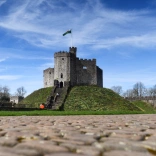Pentre Ifan, Newport
Pentre Ifan is one of the most famous sites. It is well signposted and quite easy to get to. Set in stunning landscape the dolman frames the legendary Carn Ingli or Angel Mountain, with views to the sweeping Newport bay and Dinas Island, one can truly believe our ancestors shared in our sense of place and concept of beauty. Just the elegant bare bones of stone suggest a chamber where the dead of a community may have been deposited over 5000 years ago.


Carreg Samson, Abercastle
This Cromlech is set in the most stunning location. People often gasp in delight at their first glimpse. Set on top of cliffs near to Abercastle, Carreg Samson nestles in lush farmland overlooking Strumble Head. This gem of a chamber divulged some of its secrets when it was excavated several years ago - a huge coarse fragile bowl held the cremated remains of several people before the burial was sealed beneath a floor of yellow clay.

Carreg Coetan Arthur, Newport
This site in Newport (not to be confused with Coetan Arthur on St Davids Head, below) is signposted from the road that leads across the river bridge to the sands. This dear little mushroom-like chamber is a favourite with visitors from all over the world. It is an unexpected treat as it sits amongst houses cut off from the world in a small enclosure. If you clamber up and look over the wall, you can see that it once overlooked the estuary, and one can imagine the builders using simple coracles or dugout canoes. Indeed, Carreg Coetan Arthur may well have been a declaration of ownership, placed by the water to ward off strangers.

Coetan Arthur, St Davids Head
Coetan Arthur set out on the tip of St Davids Head is accessible to walkers and is a worthy reward for the effort to get there. Perched between two rocky outcrops with views over sea, beach and rugged hilltops, this monument really does bridge the imagination and puts one in touch with those who were here before us. You may pass the Iron Age fort en route with visible hut circles and it is interesting to think that folk in the Iron Age regarded the tomb builders as an ancient and probably mythical people.






